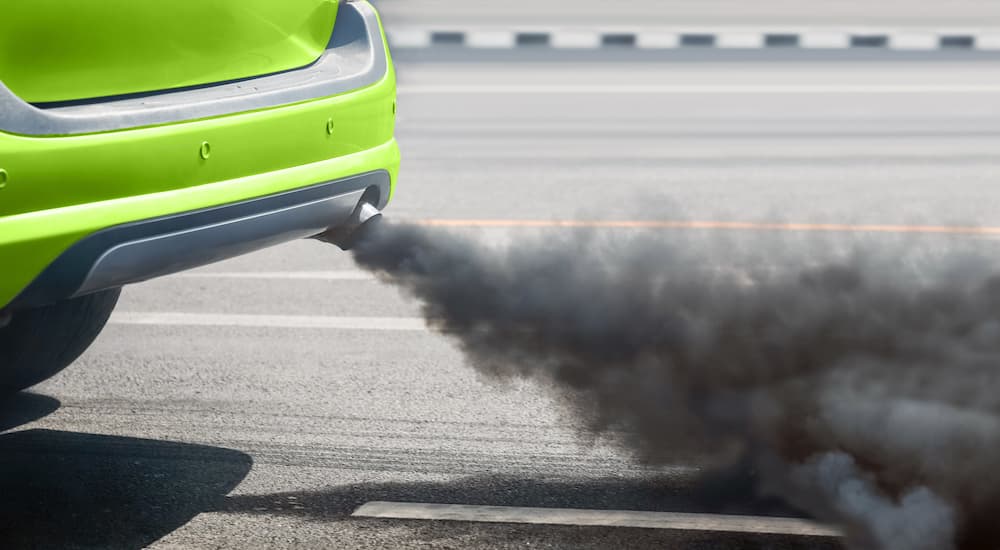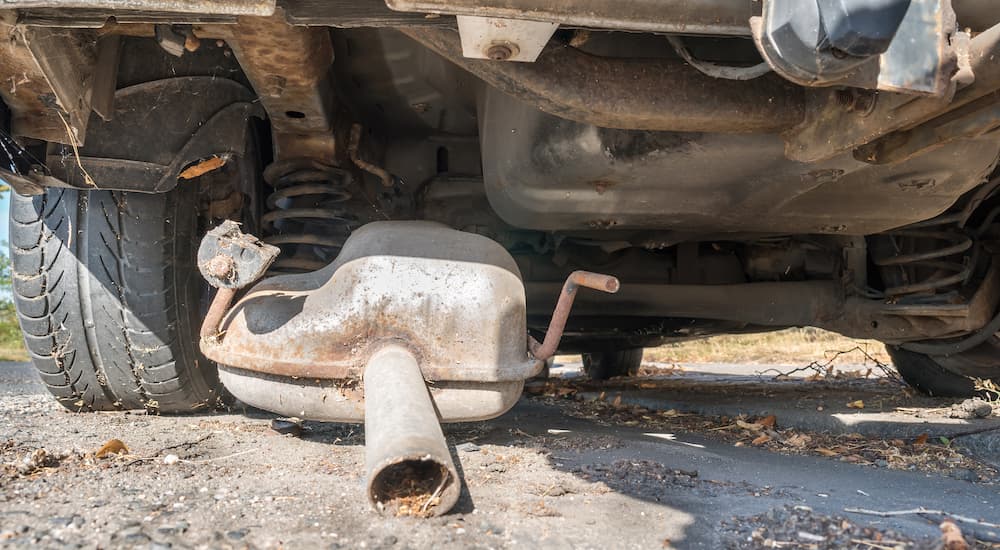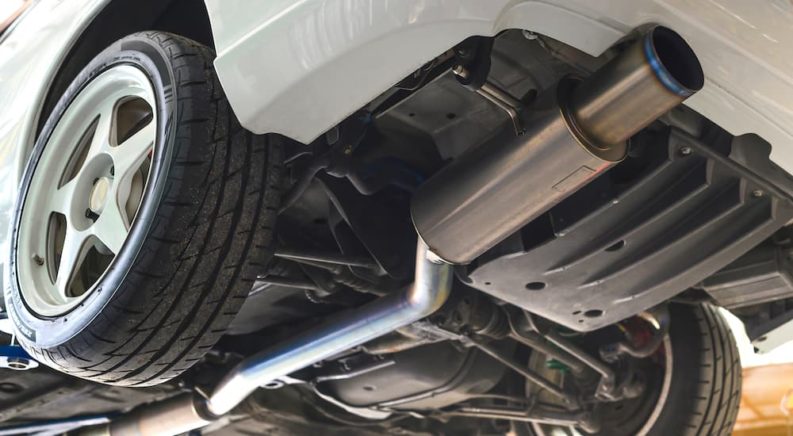There are few things more alarming than a vehicle releasing smelly, smoky fumes, but when is a problem serious enough to warrant calling a professional? Diagnosing exhaust issues at home can save you a lot of time and money, so keep an eye, nose, or ear out for warning signs. Check things out for yourself before you start paying by the hour for someone’s expert opinion. That said, while this guide is designed to be thorough, if not…exhaustive, if you’re still having trouble diagnosing the problem, your local exhaust shop is always a great resource. Search online for “exhaust shop near me” to find an expert in your area.
What’s Exhaust, Really?
Before we dive in, a little Exhaust 101 might be in order. Unlike some of the more complex systems inside today’s vehicles, the exhaust is fairly easy to wrap your head around. But, a quick refresher couldn’t hurt.
When any internal-combustion engine (ICE) vehicle is running, it produces “exhaust.” However, that’s a general term for a number of distinct gasses released as part of the internal combustion process. In order for a vehicle to run at peak efficiency, these gasses need to be properly vented, cleaned, and muffled before exiting out of the tailpipe. When your vehicle is in operation, each engine cylinder vents its exhaust gas into shared exhaust manifolds, which funnel these fumes away from the engine, clearing the air and allowing for efficient combustion to take place.
Next, exhaust gasses are fed through a catalytic converter. This vital—and expensive—component scrubs the more harmful gasses from the exhaust through the use of rare earth metals like rhodium, platinum, and palladium. It’s these rare metals that contribute to the catalytic converter’s steep price tag, which can run anywhere between $500 and $2,000. It also makes this component a particularly alluring target for thieves. Located under the vehicle and easily accessible to any motivated individual (with a wrench, reciprocating saw, and general disregard for the law), catalytic converter thefts have been on the rise recently.
As we mentioned before, exhaust is made up of many different gasses, three of which are especially dangerous: carbon monoxide, nitrogen oxide, and various hydrocarbons. The catalytic converter is able to convert up to 90 percent of these emissions into safer forms: primarily carbon dioxide, nitrogen, and water vapor. Oxygen sensors mounted downwind from the catalytic converter read the O2 levels of exhaust gasses as they exit, which are compared against O2 sensors mounted downwind from the exhaust manifold as a means of measuring the system’s efficiency. If these sensors detect either too much or too little oxygen, the vehicle can subtly adjust the engine to achieve a better balance and improve performance.
After leaving the converter, the exhaust is routed through a muffler or silencer—basically a maze of tubes that drastically reduce the volume of the exhaust by tuning its sound waves to cancel themselves out. Lastly, exhaust is fed through the tailpipe, where it exits the vehicle in a decidedly cleaner and quieter form than when it left the cylinders. With that out of the way, let’s look at some common signs of a malfunctioning exhaust system.
Smoke Signals
Checking the color of the emissions pumping out of your tailpipe is one of the easiest ways to diagnose an exhaust system issue. While not foolproof, the following exhaust color guide can give you a solid headstart when playing automotive detective.
Blue Exhaust
Blue smoke is a sign that there is too much oil burning within your engine’s cylinders. The smoke might also appear more gray-blue, but either way, it’s often paired with a burning smell. Blue exhaust usually indicates either damaged valve seals or piston rings, or worn cylinder walls. If you want to narrow it down a little further, remember that seeing blue smoke when accelerating usually indicates damage to your piston rings, whereas blue smoke during deceleration means damage to your cylinder heads’ valve guides. These are both issues that a qualified mechanic should address, but walking into a garage with a general idea of the problem is never a bad idea.

Black Exhaust
Black exhaust indicates that you might be burning not oil, but fuel. This can drastically lower your vehicle’s fuel efficiency, so if it’s not tackled quickly, that money you’re spending at the pump could be going up in smoke (literally). Likely culprits include fuel injectors and air filters, both of which can become clogged and result in black exhaust. While not exactly a beginner task, both of these components can be cleaned and replaced at home if you’re a competent mechanic—and if you’re looking to save a little money.
White/Gray Exhaust
To many people, exhaust might seem sort of white/gray in general, but particularly thick, billowing, white or gray exhaust likely means you have coolant burning within your engine. This could very well be the most serious and expensive of the three exhaust colors listed here. Why? It could indicate cracked or damaged cylinder heads, engine block, or head gaskets. None of those fixes are easy or cheap, and all can lead to further issues if not addressed promptly, so you might want to leave this one to the pros.
The Nose Knows
Smell can be another easy way to quickly diagnose exhaust issues. Certain exhaust smells are often associated with specific malfunctions and, when paired with exhaust color readings, can be highly useful in tracking down problems. We’ve listed some common smells below, but my lawyer insists that I remind you not to go too wild huffing exhaust fumes.
No Smell
Sometimes, no smell can be worse than noxious odor. If your exhaust system is leaking somewhere upstream of the catalytic converter, dangerous gasses can easily make their way into the cabin. Carbon monoxide (CO) is one prime suspect, though it can be difficult to diagnose this, as CO is odorless and colorless. If you find yourself regularly getting sleepy behind the wheel, it could well indicate the presence of carbon monoxide, a serious and potentially deadly gas that a mechanic should address ASAP.
Sweet Smell
Sadly, even “good” smells can indicate trouble. Sweet-smelling exhaust might seem downright pleasant, but could well point to burning coolant due to damaged head gaskets, engine blocks, or cylinder heads. As mentioned above, this is often paired with white/gray exhaust and might well necessitate a major repair job.
Sulfur Smell
Before you go blaming your co-pilot for the rank odor in your car, consider some alternatives. The distinctive “rotten egg” sulfur smell is usually the result of a malfunctioning catalytic converter. Hydrogen sulfide is one of the gasses converted into a less-dangerous form through the catalytic conversion process. If yours isn’t working properly, a noxious sulfur smell is often the result. Catalytic converters don’t just clean up your emissions; a malfunctioning catalytic converter can reduce engine performance and fuel efficiency. So, it’s important to make sure yours is always in good working order.
Gasoline Smell
This might be the most difficult smell to pin down, as many drivers might have a hard time distinguishing an abnormally potent gasoline smell from your run-of-the-mill gas station potpourri. If your exhaust has a distinct gas smell, it could well indicate a fuel/air mixture that leans a little too heavily toward the “fuel” side. It takes a specific ratio of fuel and air to keep your vehicle humming along at max efficiency, but issues with fuel injectors, mass airflow sensors, or air filters can throw that ratio off. The resulting exhaust is then lousy with unburned fuel. This smell is often accompanied by black exhaust out of the tailpipe.
Sounding It Out
Sound is another useful way to diagnose exhaust issues. The volume of the noise—and where it originates from—can be key to self-diagnosis. However, these terms can often be quite subjective, so if you’re having trouble deciding if the sound you hear is more of a “pop” or a “sputter”, we’d once again direct you to handy old YouTube, where there are no shortage of videos demonstrating nearly every noise a vehicle can produce.
Sizzling/Hissing
A sizzling or hissing sound could be a sign of a worn-out catalytic converter. As the elements within the converter wear out, heat, and build up over time, this can result in a distinctive sizzling noise. This will often be accompanied by a sulfurous smell and reduce engine efficiency. These sizzling and hissing sounds could also be a symptom of an overheating engine, though that would normally be accompanied by a warning light on the dash and a steaming hood.
Exhaust Sounds
It’s normal for exhaust to make airy sounds, but where those sounds originate from can tell you a lot about a potential problem. If the exhaust noise is coming from under the hood, it could indicate something relatively simple, like a failing gasket or a loose flexible pipe connection. However, it could also reveal something far more serious, like a cracked exhaust manifold.
Exhaust sound coming from the center of the vehicle is less likely to break the bank, as it’s probably due to a hole in the exhaust pipe, or a failing seal on the catalytic converter or center resonator. In rare cases, the problem could be the catalytic converter itself—though several other symptoms, like a sulfur smell, would accompany the noise.
Finally, exhaust sounds emanating from the rear of the vehicle usually point to a failing muffler, a leak from the muffler, or some sort of loose connection in that area. Again, this is a relatively cheap fix.
Backfiring/Sputtering
A little bit of a red herring here. The tell-tale gunshot of an engine backfire might originate from the tailpipe, but it likely has little to do with the exhaust system itself. Rather, these sorts of loud popping sounds usually point to an issue with the engine itself.
Rumbling
If there is a distinct rumbling noise that seems to get faster when you start accelerating, you could be looking at a leak in the exhaust system. This could occur due to a loose connection within the exhaust—or possibly even a hole.
Rattling/Vibration
A noticeable rattling or vibrating sound usually means something is touching the exhaust pipe that shouldn’t be. This typically indicates a loose connection somewhere in the exhaust system: either a disconnected bracket, isolator, exhaust damper, or heat shield. Inspect the underside of the vehicle for any conspicuously low-hanging components; if that doesn’t do the trick, look over the muffler and catalytic converter for possible damage.

Scraping
Does it sound like there’s some metal dragging underneath your vehicle? That’s because there might be some metal dragging underneath your vehicle. The exhaust system is attached to the vehicle by a number of brackets and bolts, any of which can fail and leave you scraping components across the asphalt. Confirming this diagnosis is as easy as sticking your head under the chassis to inspect for any conspicuously low-hanging parts.
Humming/Ticking
If the vehicle produces a humming or ticking noise when starting up, which disappears when the vehicle warms up, your exhaust could be the culprit. This usually points to an issue with the manifold and could be related to anything from loose (or broken) nuts and bolts to a damaged manifold or gasket. Often, a loose oxygen sensor is to blame.
Pay Attention to Your Exhaust
Honing a few key senses to diagnose exhaust issues can pay dividends when it comes time for your next repair. Of course, it’s important to have a solid frame of reference against which to compare future issues, so it’s never a bad idea to take stock of what your vehicle sounds/smells and looks like when in proper working order as a point of comparison. Taking a little time to get acquainted with your vehicle will make it much easier to quickly diagnose any changes that could serve as early warning signs of potentially serious or expensive problems down the road.
The sounds, smells, and sights we’ve described above are a good starting point when trying to pinpoint potential exhaust issues, but further diagnostics are often called for. There are a number of at-home tests drivers can perform to narrow things down, including using tools like OBDII diagnostic trouble code readers to measure oxygen levels and airflow, but if you suspect a serious issue or simply don’t have the time for the DIY approach, your local exhaust shop can be a great resource. These pros have likely dealt with every exhaust issue under the sun and while many exhaust issues can be diagnosed from the comfort of your own driveway, sometimes there’s just no substitute for experience.

